Over the past few years, Seattle Jobs Initiative (SJI) has worked in collaboration with housing programs from across the country to support their efforts to add an intentional focus on increasing household income – particularly income from employment – to their homeless services and programs. We have worked with housing providers offering a range of services from homelessness prevention, coordinated entry, rapid re-housing and permanent supportive housing. A key driver of the interest in employment and income has been the recognition that rental assistance programs, supportive housing programs and affordable housing units often fall short of what is needed locally. Additionally, housing assistance, for those fortunate enough to receive it, is often not enough to sustain stable housing, meet basic needs or provide a platform for previously homeless households to build on. People need income to go from homeless to housed and to avoid persistent housing instability, and the most helpful form of income is provided by a good job and a career pathway.
The process of fully connecting homeless housing services with employment and training programs can be complex, requiring new partnerships, sustained collaboration across providers and the addition of new skills and roles across programs. Here, we share a brief list of insights and promising practices drawing on SJI’s work in this area.
1. Start the conversation about employment and income early on in the housing assistance process
Today, many communities face a significant shortage of supportive housing, affordable units and rental assistance funds which can leave needy households with limited or no access to housing assistance. Providers are now recognizing that for many households increasing income may be the more likely path to securing housing. In response, communities are integrating an intentional conversation about employment and income at the starting point of their housing continuum, including at Coordinated Entry and within homeless diversion services and emergency shelters. They are also developing referral agreements with local employment providers and continuing a focus on income across other housing programs and services.
2. Equip frontline housing staff with effective strategies to address the common obstacles to getting and keeping a job or participating in a job training program.
Direct service staff need to have up-to date information, access to available resources and reliable referral partners to address the frequent challenges related to getting and keeping a job while unstably housed. Ideally, housing staff can offer timely assistance for things like transportation, digital access, wage garnishment and childcare. They can also help people understand the impact of paid employment on SSI, SNAP and TANF, housing subsidies and other types of public assistance. This requires ongoing information gathering, training and resource sharing with local employment and training providers. Without these strategies and resources, the likelihood of increasing income is very difficult.
3. Build counseling skills that enable frontline staff to address the anxiety and hesitancy frequently experienced by households who need to seek employment during a time of instability.
Many housing staff possess strong core counseling skills and have been trained in motivational interviewing and coaching approaches. These abilities can be extended and applied to initiating a conversation about employment, establishing a link between increasing income and securing housing, and confronting the pressures of pursuing employment. In addition, staff can employ trauma-informed care approaches to support households as they develop plans to seek employment, participate in an employment program or sustain a current job while resolving a housing crisis.
4. Recruit a core group of local employment and training providers to work in collaboration with homeless housing programs
Housing programs need to identify and engage local employment and training providers that are aligned and committed to servicing households experiencing homelessness and housing instability. In practice, this means working together to create user-friendly referral and service coordination processes between programs and establishing regular cross-program meetings and trainings to build collaboration and communication, and to develop effective practices. Additionally, it’s important to clarify the different roles and responsibilities for each partner to avoid service duplication or gaps.
5. Offer employment and training models that align with the needs of homeless job seekers
Ideally, communities can recruit employment providers with experience serving households who are unstably housed or that are at least willing to learn and adjust their service approaches. Program models that can quickly move their participants into paid employment are typically well aligned. Effective service models include transitional jobs, subsidized employment and work-based learning programs, all of which can be accompanied by wrap-around supports. Organizations utilizing an employment social enterprise approach that frequently offers paid training or work experiences can be good options for partnership.
6. Secure funding to support the work of employment and training providers
Communities have struggled to fully utilize many traditional workforce funding streams to meet the needs of job seekers experiencing homelessness and housing instability. Among the available federal programs, the USDA/FNS SNAP Employment and Training (SNAP E&T) program is an effective option and has been utilized across the country by programs serving homeless job seekers. For more information, read our policy brief about responding to the employment and training needs of SNAP participants experiencing homelessness and housing instability.
For more information on SJI’s consulting & technical assistance or details about our work connecting housing and employment services, please contact either Nick Codd Ncodd@seattlejobsinit.com or David Kaz Dkaz@seattlejobsinit.com.

Recent Comments